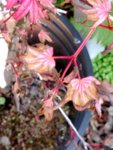0soyoung
Imperial Masterpiece
So maybe I should apply some kind of systemic? Maybe even to the wad of sphagnum while roots are developing? I've never used any systemic - do you have a recommendation?No
No. I think perhaps the mother tree lived with the disease. Sort of like a relatively healthy person living with the bacteria that causes tuberculosis. But when weakened, the bacteria prevails. So an airlayer might eventually die from losing its fight. I have a few shin Deshojo airlayers. One I still have, while the others sold. It is not strong so I ledft it to grow freely. This year is looking better.
Bacterial? Streptomycin?
Soak the sphagnum with peroxide solution periodically?
I do have a crazy thing with the spring leaves on the shoots of the previous fall growth. They usually drop and are replaced by normal shin deshojo leaves in the second flush. I used to think this was fungal, but I've now discarded that notion.


